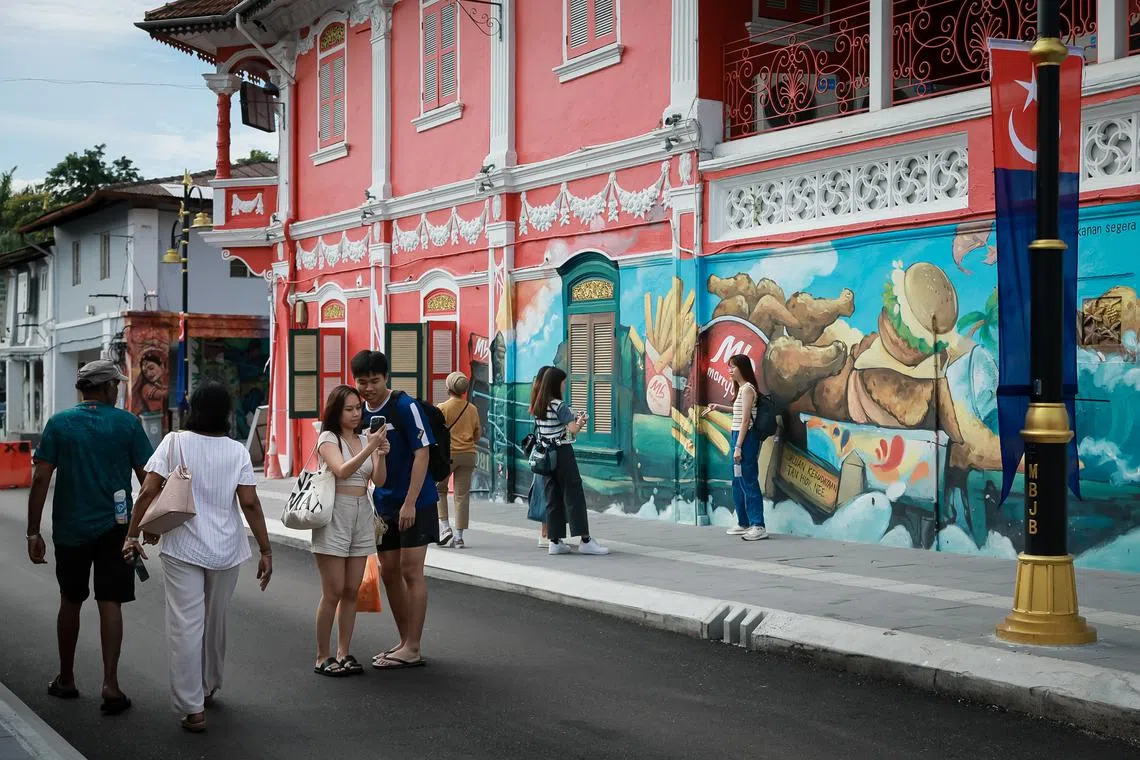S’pore retailers feel the pinch as more people are spending overseas on cheaper buys
Sign up now: Get ST's newsletters delivered to your inbox

Singaporeans enjoy day trips to Johor Bahru and tend to do their shopping and personal grooming there for a fraction of the price here.
ST PHOTO: GAVIN FOO
Follow topic:
SINGAPORE - A stronger Singdollar, pricier goods and services, and the resumption of travel plans post-pandemic have contributed to a growing number of locals preferring to spend more overseas.
This has added pressure to Singapore’s soft retail sector.
The Singapore Retailers Association (SRA) told The Straits Times that April’s sales figures have not been favourable, with most retailers reporting negative performance compared with the same month in 2023.
It said this was most likely due to the appreciation of the Singdollar. Singapore, which uses the exchange rate as its main policy tool rather than interest rates, has let the local dollar appreciate against major trading partners’ currencies
“The increased value of our currency, combined with the Singaporean penchant for travel, causes consumers to seek cheaper alternatives, especially in Japan, South Korea and Malaysia,” SRA said.
The association noted that Singaporeans consider a day trip to Johor Bahru something perfectly doable over a weekend or a public holiday, and tend to do their shopping and personal grooming there for a fraction of the price here.
For instance, a full manicure and pedicure costs $35 in Johor, compared with between $80 and $120 in Singapore.
“The stronger currency has also encouraged Singaporeans to take more holidays, and they tend to reserve their income to spend overseas, despite the additional costs incurred,” SRA said.
Among this group is Ms Allison Chew, 46, who makes three to four trips outside of Singapore in a year and buys only essentials and tech items to bring home.
“Dining in Singapore is getting increasingly costly and, more importantly, it does not offer the same experience you would get when you travel to understand its provenance and culture,” she said.
The professional in the financial services industry added that for the same amount spent on an expensive meal in Singapore, she can go for a weekend trip in South-east Asia.
“Similarly, dollar for dollar, a European meal in Singapore can buy you several better meals in Europe, so your money goes further,” she said.
IT executive Ivan Chua, 48, said his overseas purchases are 15 per cent to 30 per cent cheaper, especially with tax refunds.
He does the bundling of retail therapy and overseas trips once or twice a year.
On how doing so would mean having to spend more money because of flights and hotels, Mr Chua said it is not an issue as people tag shopping to their holiday plans or work trips.
“Nowadays, most people will do at least one to two holiday trips a year, especially Singaporeans,” he added.
SRA noted that consumers who have gone shopping overseas for items like luggage, shoes and handbags would not buy such goods again for a while.
Pressure is mounting on Singapore retailers’ businesses as goods and services are now more expensive for tourists due to the appreciation of the Singdollar.
“This is why the increase in tourist numbers did not result in stronger retail sales,” SRA said, referring to retail sales data released on May 3.
Takings at the till rose 2.7 per cent in March
Sales at supermarkets and convenience stores, and for recreational goods, furniture and household items, as well as technology equipment, were down month on month.
Economists have attributed the overall month-on-month dip to the Chinese New Year effect in February.
SRA told ST that retailers are now trying to convert consumers to online and social shopping, or engage regulars through events and workshops.
However, such efforts mean having to put in extra resources and generally do not pay off, it said.
Professor of finance and real estate Qian Wenlan from the National University of Singapore Business School said weak consumer demand could be due to the uncertain economic outlook, which puts people on edge.
“They may want to hold off shopping for a bit to have precautionary savings in case something happens to the economy, to their jobs, to the housing market or to their investments,” she said.
Prof Qian is of the view that there must be a specific pull factor, such as a lower sales tax, for more locals to prefer spending overseas – something they have been doing even in the past.
She said that while tourists are an important part of Singapore’s gross domestic product, a large part of consumption in the Republic is still driven by domestic spending.
“Looking at the trend, it may raise some red flags or a reminder for us to keep an eye on the domestic demand, which is a strong indicator of economic health. So, if people are reluctant to spend, overall, it’s not a very good sign,” added Prof Qian.


